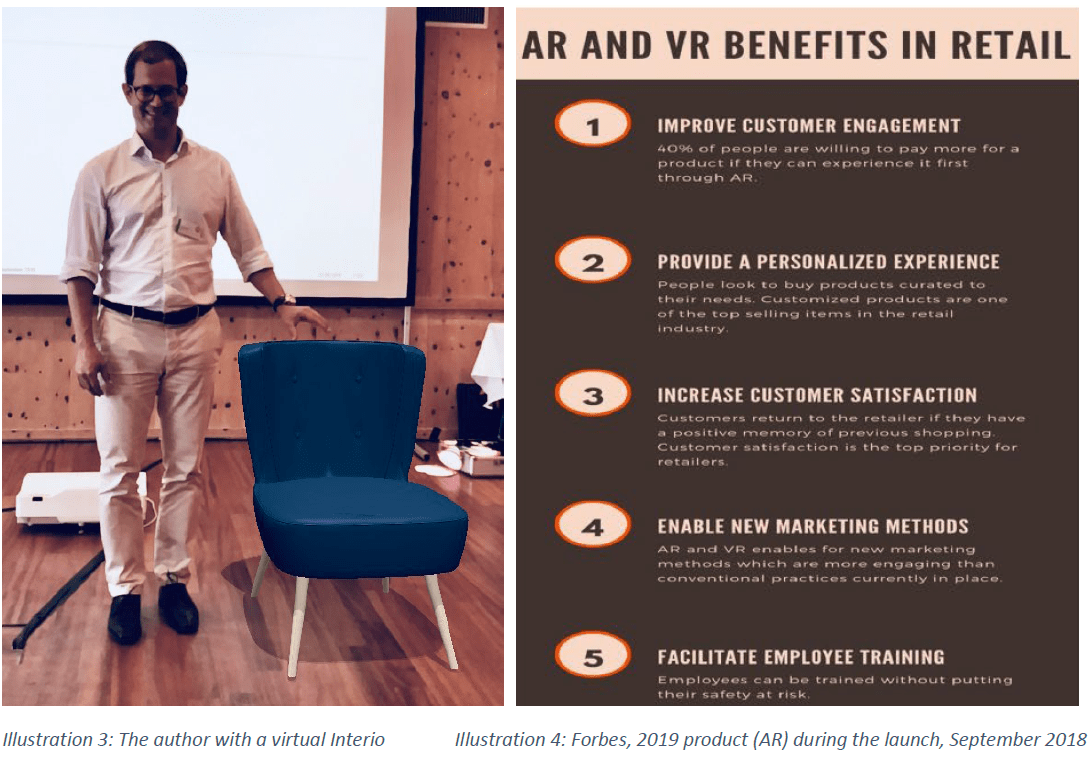AR, VR & 3D printing as opportunities in the furniture industry
In view of declining visitor numbers in stores, how can the furniture industry succeed in finding suitable digital tools to counteract this or in achieving a better conversion rate through the ROPO effect or ultimately in the furniture store itself (frequenc -purchasing customers)? Augmented reality (AR), virtual reality (VR) and 3D printing can provide assistance here. What needs taking into consideration and what exactly are the goals?

For many years, one of the biggest problems in the furniture trade has been that many customers cannot imagine their new piece of furniture in their own surroundings. This uncertainty hinders purchases on the spot directly, delays the purchase process as a whole and, in the worst case, may even prevent the purchase altogether. This potential for uncertainty also leads the consumer to be very conservative in terms of design, especially when purchasing large furnishing items, to ensure any design-related risks are kept to a minimum. This in turn reduces the opportunities for differentiation within the furniture trade and leads to increased price competition. AR and VR, and also 3D printing to a certain extent, are modern technologies that can help customers in this respect. Up until now, specialist dealers have relied on either hand-drawn sketches and drawings or elaborate CAD visualisations and collages. Large-scale furniture stores may have one or two skilful sales staff, who are able to provide some level of certainty in terms of design by creating such sketches. As a rule, however, the customer’s demand for more design certainty is not explicitly satisfied!

A year ago, Interio became the second furniture store in Switzerland to launch an AR app. IKEA entered the international market somewhat earlier in this regard. However, Interio impressed with a suitable shop connection and better usability. The aim of the app, which was co-developed by the author as project manager, is to provide the customer with design certainty in order to promote sales both online and in stores. A first stumbling block in such projects is the provision of a clean data base. AR, VR and 3D printing need good 3D models of the products to be displayed. Finding the right price/performance ratio here is challenging, as this aspect can easily break the budget or seriously affect the customer experience! It’s worthwhile taking enough time when searching for suppliers, because often the agency that develops the app is not the right one for 3D model development. Nevertheless, the launch of an AR app nowadays is no longer a question of wizardry, and they can certainly be financed. Other factors determine success or failure:
1. Is it being launched and communicated with sufficient emphasis and then kept at the forefront of people’s minds?
2. Do employees use the tool with the customer in the sales area?
3. Is the continuous development and maintenance of the app guaranteed?
It takes courage and determination on the part of management to launch a digital tool emphatically. If these are missing, it simply won’t work. It’s better to leave things be if there’s no taste for this. After all, employees will notice it too, and it’s just as important to win them over as it is customers. It is an innovative additional service – a consulting service that goes far beyond the sale of goods – which in turn also helps to ensure new customer loyalty. Another possible stumbling block is the commission system, because digital tools encourage people to change channels! How do I motivate a customer adviser in the furniture store to support a customer’s change of sales channel without depriving him of his commission? Don’t forget that the customer will change medium/channel as and when they want. Nobody can prevent this!
In many ways, VR works similarly. However, there is another problem here, which relates to creating the environment. Realistically, retailers can only solve this problem with test or sample environments, since an individual, customer-specific option is simply not financially viable at present. On the other hand, this does make sense for large real estate projects, as synergies exist between the various units to be managed or sold, which means unit costs can be reduced significantly. Partnerships between furnishing companies and a good 3D product library and real estate developers provide obvious benefits…
3D printing opens up completely different possibilities – always building on a good 3D product library/database, which is also necessary for AR and VR. A basic solution may be the 1:10 print of a «general» sofa as a model, as offered by practically all suppliers with a corresponding product system. It replaces existing, general models or other tools currently in use – ultimately with similar benefits. Conclusion: cool tool for sales support, but ultimately no better than those already available today! The printing of a furnishing item on a scale of 1:1 as a complete product goes a lot further when it comes to securing a sale! Chairs are currently still too expensive to print or produce on site, but decorative objects work very well in this regard. These can be individualised for each customer at the POS (size, texture, colour), which ultimately provides the customer with a unique product. The stored models (data) could also be distributed online, enabling them to be printed out individually. At the moment this is certainly still just a dream, but reality is not too far away. Be prepared! New business models will emerge from this and further uproot our furniture world.
The potential of personalised offers today can be seen in the following charts.

The potential is unlikely to shrink! And as usual, there will be winners and losers. Digitisation demands a lot from the furniture trade. Take advantage of the opportunities it provides!
In summary:
1. Create a database with 3D models of your products. You will need it (soon)!
2. AR is a very suitable and already pretty mature means for the industry to simulate the effect of products and provide the customer with certainty when it comes to design.
3. At the moment, VR is particularly suitable for cooperation in contract business.
4. 3D printing requires good printers. For an initial test in the area of accessories, it certainly makes sense.

